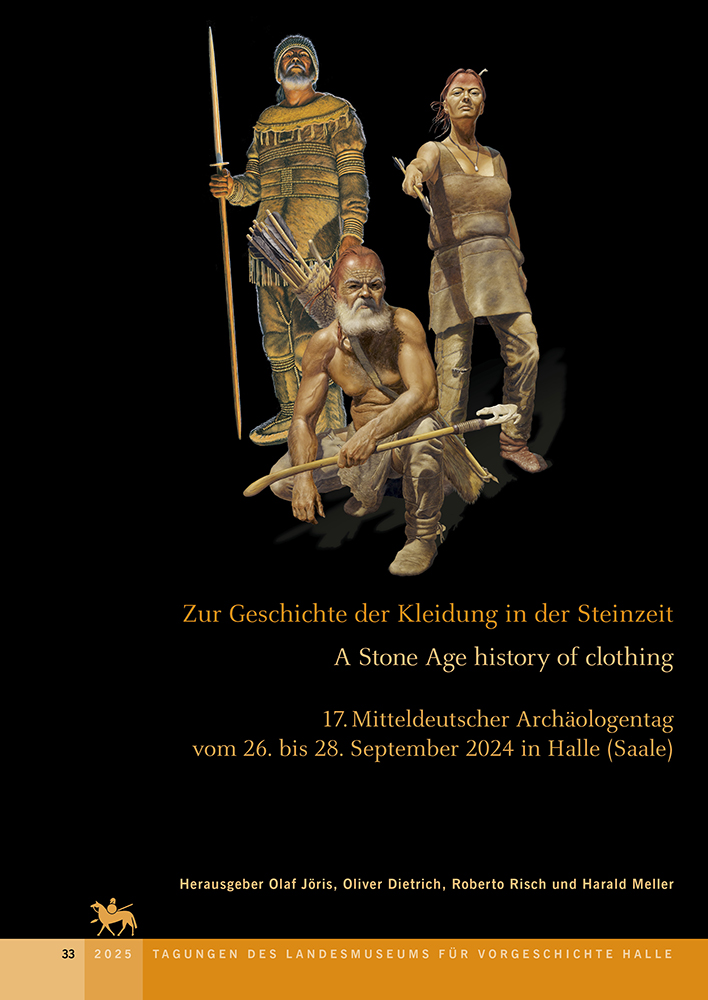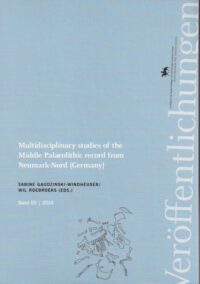17. Mitteldeutscher Archäologentag vom 26. bis 28. September 2024 in Halle (Saale)
Wie kleideten sich die Menschen in der Steinzeit, welche Materialien und Techniken nutzten sie und wie lassen sich diese nachweisen? Ist der Beginn der Kleidung auf ein aufkommendes Schamgefühl oder auf den praktischen Schutz vor der Witterung zurückzuführen? Eng verbunden mit diesen Fragen ist die Untersuchung von Mensch-Tier-Beziehungen und welchen Einfluss diese bei der Wahl der Rohmaterialien für die Herstellung von Schmuck und Kleidung hatten.
Diesen und weiteren zentralen Fragestellungen widmet sich dieser Band mit einem interdisziplinären Ansatz aus Archäologie, Natur-, Kultur- und Medienwissenschaften. Dafür werden in den vorliegenden Studien direkte Belege wie Fundkontexte aus Bestattungen untersucht sowie indirekte Belege über figürliche Darstellungen oder Werkzeuge herangezogen, um (Be)Kleidung in ihrer evolutionären und sozialen Bedeutung zu betrachten.
How did people dress in the Stone Ages, what materials and techniques did they use and how can they be traced? Is the beginning of clothing a result of an evolving sense of shame or just a practical protection against the elements? Closely linked is the investigation of human-animal relationships and what influence these had on the choice of raw materials for the production of jewellery and clothing.
This volume addresses these and other key questions in an interdisciplinary approach combining archaeology, natural sciences, cultural and media studies. To this end, the present studies examine direct evidence such as burials as well as indirect evidence from figurative depictions or tools in order to analyse the evolutionary and social significance of clothing.
Inhalt/Contents
Olaf Jöris, Oliver Dietrich, Harald Meller, and Roberto Risch
• A Stone Age history of clothing – an introduction
Sektion I: Von der Fiktion zur Wissenschaft und zurück – Kleidungsrekonstruktionen und Wahrnehmung/From fiction to science and back to fiction – Clothing reconstructions and perception
Pauline Coste
• Clothing or nakedness in reconstructions of prehistoric humans
Kayleigh Saunderson, Lukas Dobler, and Karina Grömer
• Stone Age clothes in popular media – a balance between producers, audiences, and sciences
Sektion II: Gründe, warum sich Menschen kleiden/Reasons why humans dress
Ian Gilligan
• The transition to clothing as dress
Shumon T. Hussain
• Beyond dress, protection, and disguise: Re-inserting animals into the Deep History of human clothing
Karina Grömer
• Clothing, messages, and identity – theoretical and methodological approaches to clothing in Central European prehistory
Sektion III: Kleidung als Mittel zum Schutz und Wohlbefinden/Clothing as a means of protection and well-being
Die Biologie der menschlichen Haut und Kleidung/The biology of human skin and clothing
Cristina de Guzman Strong
• Evolution of the human skin barrier as innovative clothing
Olaf Jöris
• Human evolution and the origins of Stone Age clothing
Kleidung und das biopsychologische und mentale Wohlbefinden/Clothing and the bio-psychological and mental well-being
Thomas Junker
• Kleidung und die evolutionäre Bedeutung der Scham
Wulf Schiefenhövel
• Genital cover. Dress or evolved bio-psychological impulse?
Peter Vang Petersen
• Tooth and amber amulets – magic elements of clothing in Danish Stone Age burials
Sektion IV: Materialien und Methoden zur Herstellung von Kleidung/Materials and methods in clothing production
Verwendung und Verarbeitung tierischer Ressourcen/Use and processing of animal resources
Ivo Verheijen
• Exploitation of carnivores for clothing: evidence of carnivore skinning from the Palaeolithic of Europe
Theresa Emmerich Kamper and Linda Hurcombe
• Tannage technologies available for clothing in prehistory
Tuija Kirkinen
• Feathers in Mesolithic burials
Verwendung und Verarbeitung pflanzlicher Ressourcen/Use and processing of plant resources
Veerle Rots and Sonja Tomasso
• Twining things together: how functional approaches can help to understand the processing of fibres in the Palaeolithic
Eva IJsveld and Dorothee Olthof
• Stone Age textiles – materials, techniques, and the value of reconstructions
Maria Herrero-Otal, Ingrid Bertin, Raquel Piqué, and Francisco Martínez-Sevilla
• Fibre-based technologies of the last hunter-gatherers and First Farmers in southern Europe: Baskets, cords and footwear from the Cueva de los Murciélagos site (Albuñol, Granada)
Mario Mineo, Juan F. Gibaja, Gerard Remolins, Mauro Rottoli, Laura Caruso-Fermé, Vanessa
• Forte, Berta Morell, Izaro Quevedo-Semperena, and Niccolò Mazzucco Textiles and textile production at the Neolithic site of La Marmotta, Anguillara Sabazia, Lazio (Italy)
Spezialwerkzeuge und -technologien/Specialised tools and technologies
Annelou van Gijn
• Use-wear analysis of six bone tools found in the woman’s grave of Bad Dürrenberg
María Borao Álvarez, Natacha Caurette, François-Xavier Chauvière, Romain Malgarini, and Jean-Marc Pétillon
• The Palaeolithic origin of eyed needles
Andrew W. Kandel, Boris Gasparyan, Ani Adigyozalyan, and Miriam N. Haidle
• Reverse engineering of sewing with needle-and-thread: An interpretation of complementary technology at Aghitu-3 Cave, Armenia
Susanne Friederich, Andrea Moser und Jonathan Schulz
• Flachsverarbeitung – Rottegruben im archäologischen Befund. Fallbeispiel Großgrimma, Burgenlandkreis
Martha Görlitz
• Old spindle whorls – new yarn. The functionality of different types of whorls in practical use based on a case study of Feddersen Wierde, Cuxhaven District
Kleidung und Komfort/Clothing as comfort
Susanna Harris and Aris Palyvos
• Cloth as human experience: Looping, furs, and twining in the Mesolithic of north-west Europe
Sektion V: Kleidung und Körperschmuck: Fallbeispiele/Clothing and body ornamentation: Some examples
Sibylle Wolf and Nicholas J. Conard
• Fashion trends and body ornamentation in the Upper Palaeolithic of southwestern Germany
Shuqin Guo, Stefanie Kölbl, Marian Vanhaeren, Sibylle Wolf, and Nicholas J. Conard
• Possible visual impacts of double perforated ivory beads found in the Swabian Aurignacian
Martin Street and Elaine Turner
• A Late Magdalenian ›coat of many colours‹? A new look at well-worn evidence from the sites Gönnersdorf and Andernach-Martinsberg (Germany)
Albert Hafner
• Neolithic clothing discoveries of the Alpine region. Waterlogged finds from submerged and glacial sites
Sektion VI: Kleidung und soziale Differenzierung in der Steinzeit im Spiegel
von Grabbefunden/Stone Age clothing and social differentiation as seen from burial contexts
Pauline Coste and Giacomo Giacobini
• Richness and diversity of burial rituals in the Gravettian period: Potential for clothing reconstructions in documentaries
Marian Vanhaeren
• Reconstructing clothing from Multi-Reference Analyses of personal ornaments found in Palaeolithic burials – three case studies and their implications
Kristiina Mannermaa and Riitta Rainio
• Interpreting clothing culture in late Mesolithic burials of Northern Europe based on animal tooth ornaments
Susanne Friederich, Carola Oelschlägel und Björn Schlenker
• Schnurkeramische Taschen im Saale-Unstrut-Gebiet – eine lokale Handwerkstradition mit hohem Symbolgehalt
Thorsten Uthmeier
• Egalitarian or transegalitarian? A socioeconomic perspective on status and prestige during the Magdalenian and the Mesolithic
Sektion VII: Kleidung und Körperschmuck in steinzeitlichen künstlerischen Kontexten/Clothing and body ornamentation in Stone Age artistic contexts
Olaf Jöris
• A Palaeolithic and Mesolithic artistic record of clothing – an overview
Christina Marangou
• Appearance and perceptions of Neolithic figurines – nuances of covering and nudity: Evidence from Greece
Oliver Dietrich
• Cloak, belt, and loincloth. 10th–9th millennium BC depictions of clothing from Göbekli Tepe and other Upper Mesopotamian sites
Simon Kaner
• Wrapping the Stone Age body: Clothing Jōmon dogū ceramic figures from the prehistoric Japanese archipelago





